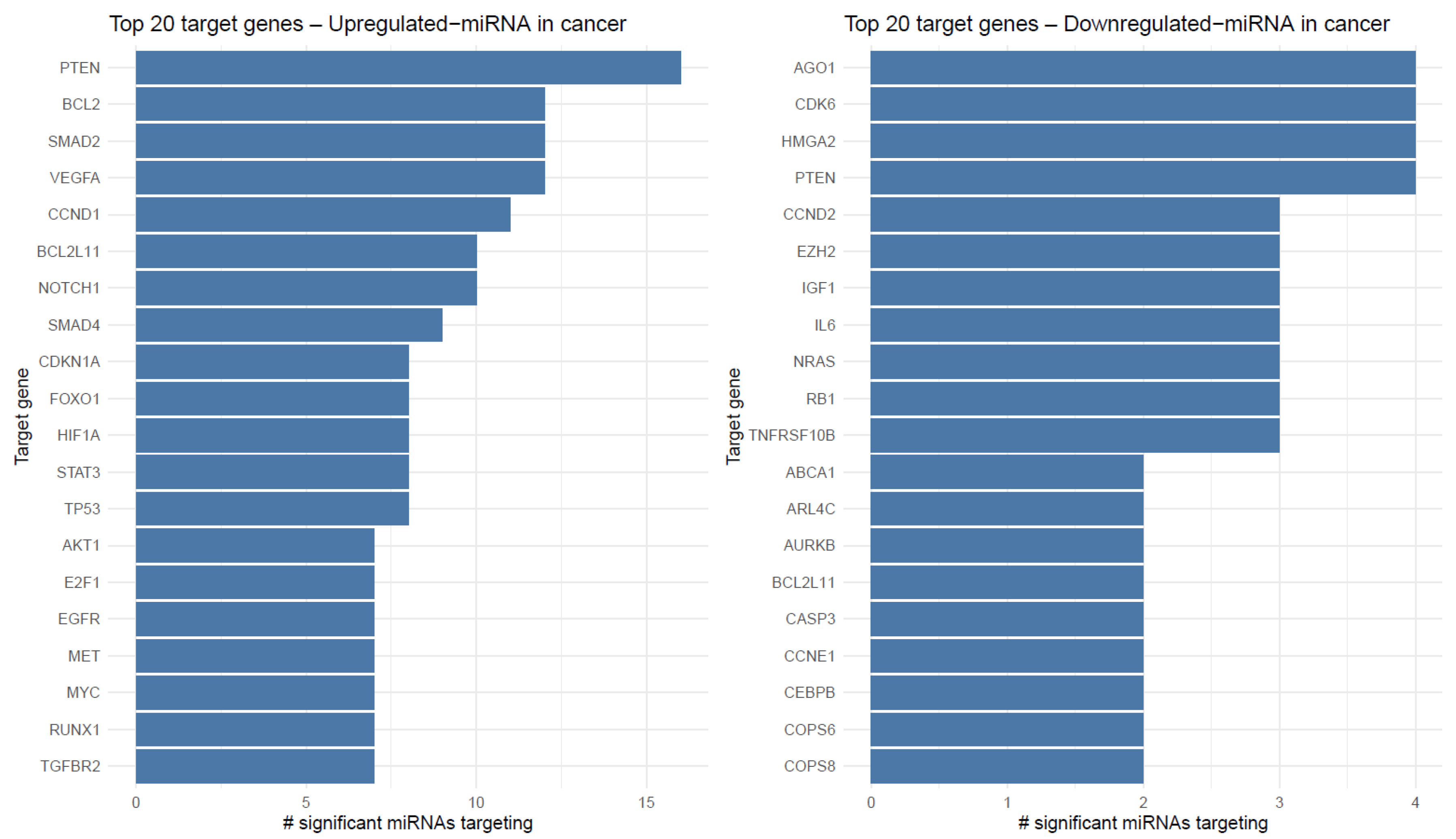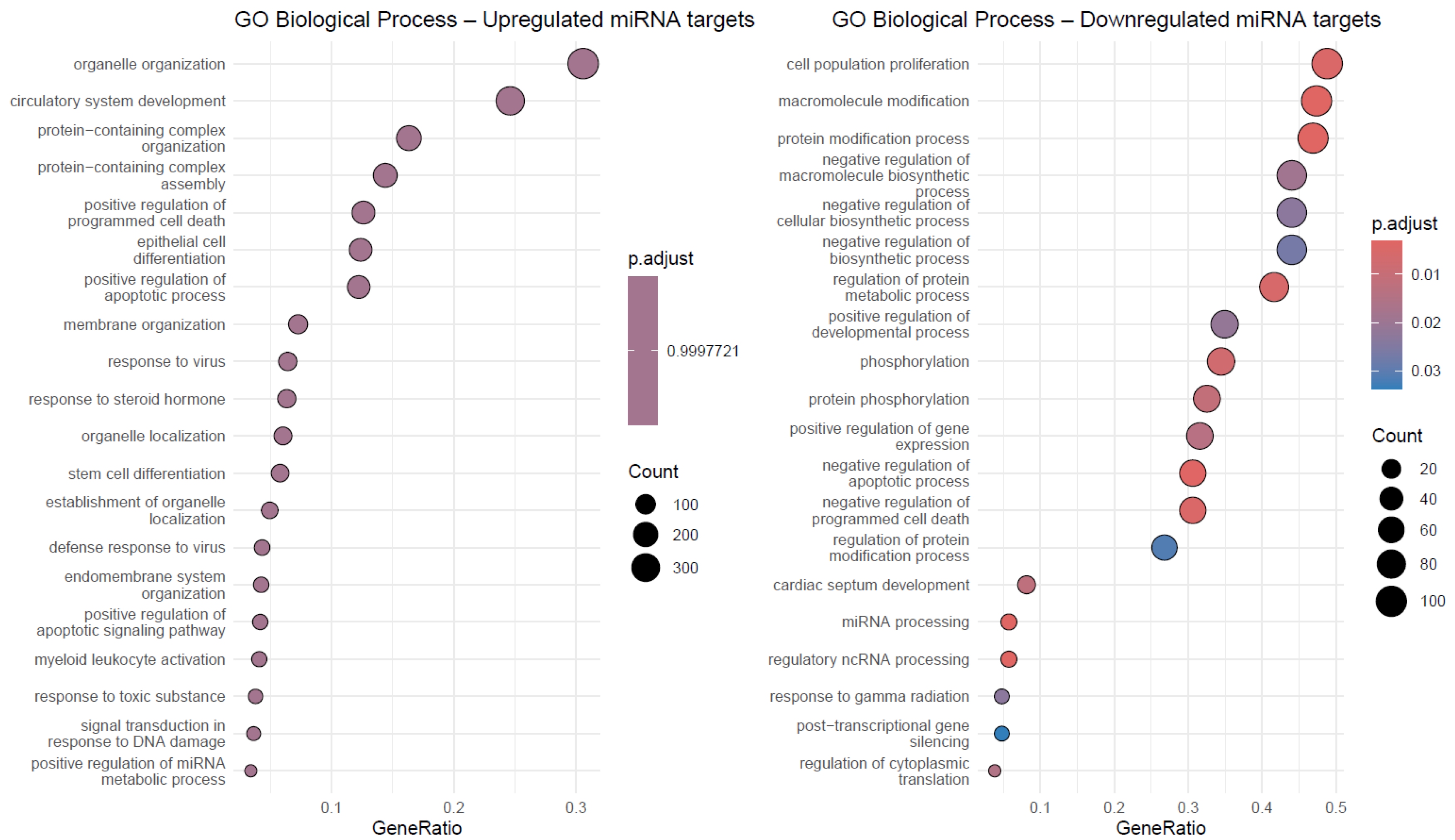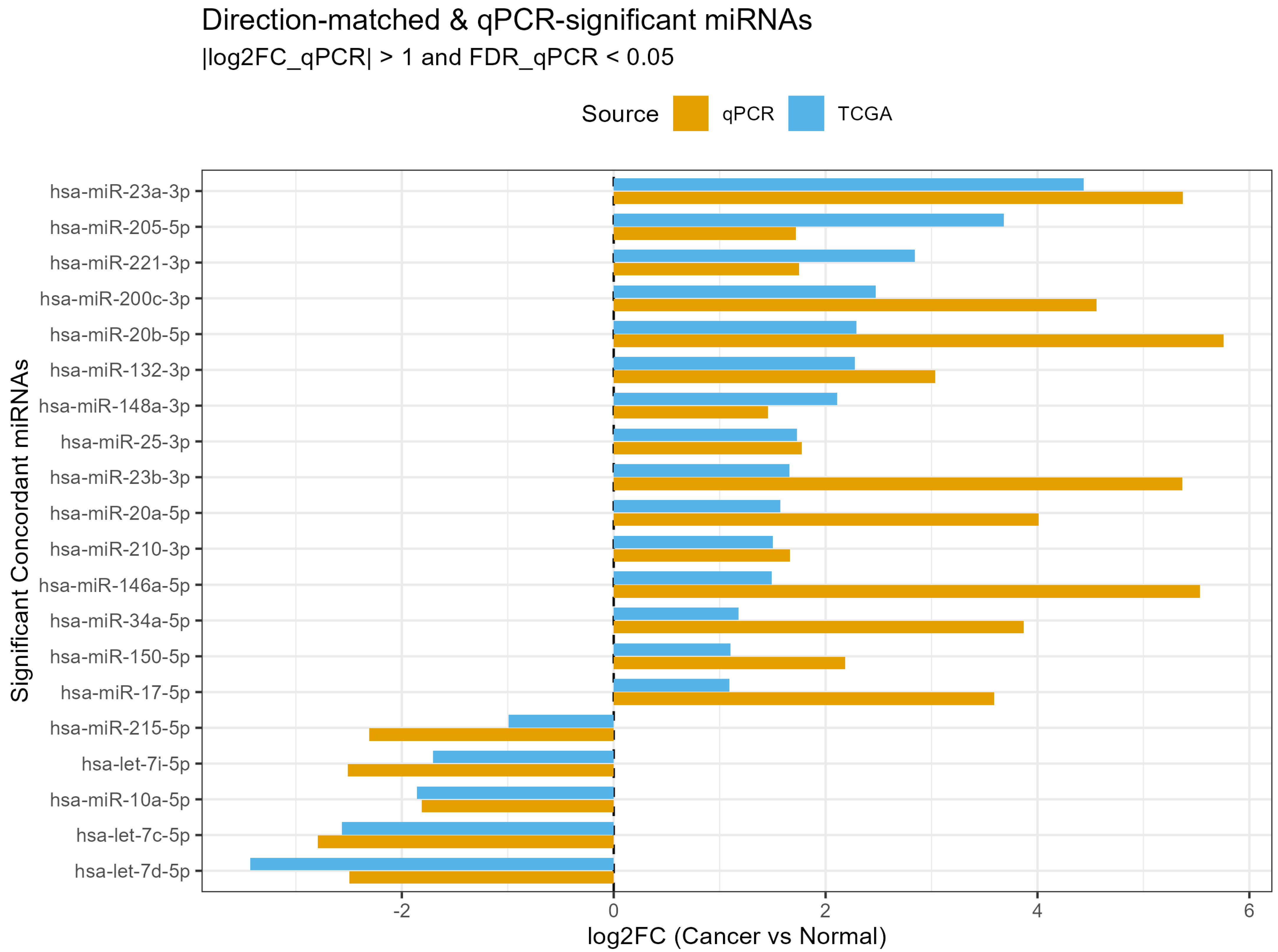miRNA Signatures in Endometrial Cancer: Implications for Oncogenesis and Polymerase Epsilon (POLE) Mutation Status
Abstract
1. Introduction
2. Results
2.1. Differential Expression of miRNAs Between Cancer and Healthy Groups
2.2. miRNA–Gene Target Convergence
2.3. Functional Enrichment of Target Gene Sets
2.4. Differential Expression of miRNAs Between POLE+ and POLE− Tumors
2.5. Validation Against TCGA miRNA-Seq
3. Discussion
4. Materials and Methods
4.1. Patients and Tissue Samples
4.2. POLE Genotyping
4.3. MiRNA Expression and Bioinformatics Analysis
5. Conclusions
Supplementary Materials
Author Contributions
Funding
Institutional Review Board Statement
Informed Consent Statement
Data Availability Statement
Conflicts of Interest
References
- Bartel, D.P. MicroRNAs: Genomics, biogenesis, mechanism, and function. Cell 2004, 116, 281–297. [Google Scholar] [CrossRef]
- Esquela-Kerscher, A.; Slack, F.J. Oncomirs—MicroRNAs with a role in cancer. Nat. Rev. Cancer 2006, 6, 259–269. [Google Scholar] [CrossRef]
- Calin, G.A.; Croce, C.M. MicroRNA signatures in human cancers. Nat. Rev. Cancer. 2006, 6, 857–866. [Google Scholar] [CrossRef]
- Siegel, R.L.; Miller, K.D.; Wagle, N.S.; Jemal, A. Cancer statistics, 2023. CA Cancer J. Clin. 2023, 73, 17–48. [Google Scholar] [CrossRef]
- Levine, D.; The Cancer Genome Atlas Research Network. Integrated genomic characterization of endometrial carcinoma. Nature 2013, 497, 67–73, Erratum in Nature 2013, 500, 242. [Google Scholar] [CrossRef]
- Oropeza-de Lara, S.A.; Garza-Veloz, I.; Berthaud-González, B.; Martinez-Fierro, M.L. Circulating and Endometrial Tissue microRNA Markers Associated with Endometrial Cancer Diagnosis, Prognosis, and Response to Treatment. Cancers 2023, 15, 2686. [Google Scholar] [CrossRef]
- Lee, J.W.; Park, Y.A.; Choi, J.J.; Lee, Y.Y.; Kim, C.-J.; Choi, C.; Kim, T.-J.; Lee, N.W.; Kim, B.-G.; Bae, D.-S. The expression of the miRNA-200 family in endometrial endometrioid carcinoma. Gynecol. Oncol. 2011, 120, 56–62. [Google Scholar] [CrossRef] [PubMed]
- Indumati, S.; Apurva, B.; Gaurav, G.; Nehakumari, S.; Nishant, V. The Role of MicroRNAs in Development of Endometrial Cancer: A Literature Review. J. Reprod. Infertil. 2023, 24, 147–165. [Google Scholar] [CrossRef] [PubMed]
- Karaayvaz, M.; Zhang, C.; Liang, S.; Shroyer, K.R.; Ju, J. Prognostic significance of miR-205 in endometrial cancer. PLoS ONE 2012, 7, e35158. [Google Scholar] [CrossRef] [PubMed]
- Yang, J.; Barkley, J.E.; Bhattarai, B.; Firouzi, K.; Monk, B.J.; Coonrod, D.V.; Zenhausern, F. Identification of Endometrial Cancer-Specific microRNA Biomarkers in Endometrial Fluid. Int. J. Mol. Sci. 2023, 24, 8683. [Google Scholar] [CrossRef]
- Lazaridis, A.; Katifelis, H.; Kalampokas, E.; Lambropoulou, D.; Aravantinos, G.; Gazouli, M.; Vlahos, N.F. Utilization of miRNAs as Biomarkers for the Diagnosis, Prognosis, and Metastasis in Gynecological Malignancies. Int. J. Mol. Sci. 2024, 25, 11703. [Google Scholar] [CrossRef]
- Church, D.N.; Briggs, S.E.; Palles, C.; Domingo, E.; Kearsey, S.J.; Grimes, J.M.; Gorman, M.; Martin, L.; Howarth, K.M.; Hodgson, S.V.; et al. DNA polymerase ε and δ exonuclease domain mutations in endometrial cancer. Hum. Mol. Genet. 2013, 22, 2820–2828. [Google Scholar] [CrossRef]
- León-Castillo, A.; Gilvazquez, E.; Nout, R.; Smit, V.T.; McAlpine, J.N.; McConechy, M.; Kommoss, S.; Brucker, S.Y.; Carlson, J.W.; Epstein, E.; et al. Clinicopathological and molecular characterisation of ‘multiple-classifier’ endometrial carcinomas. J. Pathol. 2020, 250, 312–322. [Google Scholar] [CrossRef] [PubMed]
- McConechy, M.K.; Talhouk, A.; Leung, S.; Chiu, D.; Yang, W.; Senz, J.; Reha-Krantz, L.J.; Lee, C.-H.; Huntsman, D.G.; Gilks, C.B.; et al. Endometrial Carcinomas with POLE Exonuclease Domain Mutations Have a Favorable Prognosis. Clin. Cancer Res. 2016, 22, 2865–2873. [Google Scholar] [CrossRef] [PubMed]
- Yao, X.; Feng, M.; Wang, W. The Clinical and Pathological Characteristics of POLE-Mutated Endometrial Cancer: A Comprehensive Review. Cancer Manag. Res. 2024, 16, 117–125. [Google Scholar] [CrossRef]
- Wu, Q.; Zhang, N.; Xie, X. The clinicopathological characteristics of POLE-mutated/ultramutated endometrial carcinoma and prognostic value of POLE status: A meta-analysis based on 49 articles incorporating 12,120 patients. BMC Cancer 2022, 22, 1157. [Google Scholar] [CrossRef]
- Wei, T.Y.; Wu, C.C.; Hsu, Y.T.; Lin, W.-H.; Tsai, L.-C.; Shieh, D.-B.; Chang, C.-L. An exploratory analysis of driver gene alterations and their potential prognostic relevance in endometrial cancer with POLE exonuclease domain mutations. Gynecol. Oncol. 2025, 199, 17–26. [Google Scholar] [CrossRef] [PubMed]
- He, S.; Zeng, S.; Zhou, Z.W.; He, Z.X.; Zhou, S.F. Hsa-microRNA-181a is a regulator of a number of cancer genes and a biomarker for endometrial carcinoma in patients: A bioinformatic and clinical study and the therapeutic implication. Drug Des. Dev. Ther. 2015, 9, 1103–1175. [Google Scholar]
- Iavarone, I.; Molitierno, R.; Fumiento, P.; Vastarella, M.G.; Napolitano, S.; Vietri, M.T.; De Franciscis, P.; Ronsini, C. MicroRNA Expression in Endometrial Cancer: Current Knowledge and Therapeutic Implications. Medicina 2024, 60, 486. [Google Scholar] [CrossRef]
- Takebayashi, K.; Nasu, K.; Okamoto, M.; Aoyagi, Y.; Hirakawa, T.; Narahara, H. hsa-miR-100-5p, an overexpressed miRNA in human ovarian endometriotic stromal cells, promotes invasion through attenuation of SMARCD1 expression. Reprod. Biol. Endocrinol. 2020, 18, 31. [Google Scholar] [CrossRef]
- Jiang, F.; Liu, T.; He, Y.; Yan, Q.; Chen, X.; Wang, H.; Wan, X. MiR-125b promotes proliferation and migration of type II endometrial carcinoma cells through targeting TP53INP1 tumor suppressor in vitro and in vivo. BMC Cancer 2011, 11, 425. [Google Scholar] [CrossRef]
- Liu, P.; Wang, C.; Ma, C.; Wu, Q.; Zhang, W.; Lao, G. MicroRNA-23a regulates epithelial-to-mesenchymal transition in endometrial endometrioid adenocarcinoma by targeting SMAD3. Cancer Cell Int. 2016, 16, 67. [Google Scholar] [CrossRef]
- Liu, P.; Qi, M.; Ma, C.; Lao, G.; Liu, Y.; Liu, Y.; Liu, Y. Let7a inhibits the growth of endometrial carcinoma cells by targeting Aurora-B. FEBS Lett. 2013, 587, 2523–2529. [Google Scholar] [CrossRef] [PubMed]
- Jayaraman, M.; Radhakrishnan, R.; Mathews, C.A. Identification of novel diagnostic and prognostic miRNA signatures in endometrial cancer. Genes Cancer 2017, 8, 566–576. [Google Scholar] [CrossRef]
- Cao, R.; Zhao, J.; Zhang, J. LINC01857 Exacerbates the Malignant Behaviors of Endometrial Carcinoma Cells by Sponging miR-19b-3p and Recruiting ELAVL1 to Upregulate MYCN. Gynecol. Obstet. Investig. 2023, 88, 16–29. [Google Scholar]
- Oropeza-de Lara, S.A.; Garza-Veloz, I.; Berthaud-González, B.; Tirado-Navarro, T.G.; Gurrola-Carlos, R.; Bonilla-Rocha, B.; Delgado-Enciso, I.; Martinez-Fierro, M.L. Comparative Assessment of miR-185-5p and miR-191-5p Expression: From Normal Endometrium to High-Grade Endometrial Cancer. Cells 2024, 13, 1099. [Google Scholar] [CrossRef] [PubMed]
- Klicka, K.; Grzywa, T.M.; Klinke, A.; Mielniczuk, A.; Włodarski, P.K. The Role of miRNAs in the Regulation of Endometrial Cancer Invasiveness and Metastasis-A Systematic Review. Cancers 2021, 13, 3393. [Google Scholar] [CrossRef]
- Ihira, K.; Dong, P.; Xiong, Y.; Watari, H.; Konno, Y.; Hanley, S.J.; Noguchi, M.; Hirata, N.; Suizu, F.; Yamada, T.; et al. EZH2 inhibition suppresses endometrial cancer progression via miR-361/Twist axis. Oncotarget 2017, 8, 13509–13520. [Google Scholar] [CrossRef]
- Favier, A.; Rocher, G.; Larsen, A.K.; Delangle, R.; Uzan, C.; Sabbah, M.; Castela, M.; Duval, A.; Mehats, C.; Canlorbe, G. MicroRNA as Epigenetic Modifiers in Endometrial Cancer: A Systematic Review. Cancers 2021, 3, 1137. [Google Scholar] [CrossRef]
- Lee, Y.S.; Dutta, A. The tumor suppressor microRNA let-7 represses the HMGA2 oncogene. Genes Dev. 2007, 21, 1025–1030. [Google Scholar] [CrossRef]
- Snowdon, J.; Zhang, X.; Childs, T.; Tron, V.A.; Feilotter, H. The microRNA-200 family is upregulated in endometrial carcinoma. PLoS ONE 2011, 6, e22828. [Google Scholar] [CrossRef]
- Arciuolo, D.; Travaglino, A.; Raffone, A.; Raimondo, D.; Santoro, A.; Russo, D.; Varricchio, S.; Casadio, P.; Inzani, F.; Seracchioli, R.; et al. TCGA Molecular Prognostic Groups of Endometrial Carcinoma: Current Knowledge and Future Perspectives. Int. J. Mol. Sci. 2022, 23, 11684. [Google Scholar] [CrossRef]
- Campos Segura, A.V.; Velásquez Sotomayor, M.B.; Gutiérrez Román, A.I.F.; Ortiz Rojas, C.A.; Murillo Carrasco, A.G. Impact of mini-driver genes in the prognosis and tumor features of colorectal cancer samples: A novel perspective to support current biomarkers. PeerJ 2023, 11, e15410. [Google Scholar] [CrossRef] [PubMed]
- Pradervand, S.; Weber, J.; Lemoine, F.; Consales, F.; Paillusson, A.; Dupasquier, M.; Thomas, J.; Richter, H.; Kaessmann, H.; Beaudoing, E.; et al. Concordance among digital gene expression, microarrays, and qPCR when measuring differential expression of microRNAs. Biotechniques 2010, 48, 219–222. [Google Scholar] [CrossRef]
- Liu, W.; Bai, W. Association of endometrial thickness with lesions in postmenopausal asymptomatic women: Risk factors and diagnostic thresholds. BMC Womens Health 2025, 25, 105. [Google Scholar] [CrossRef]
- Berek, J.S.; Matias-Guiu, X.; Creutzberg, C.; Fotopoulou, C.; Gaffney, D.; Kehoe, S.; Lindemann, K.; Mutch, D.; Concin, N.; Endometrial Cancer Staging Subcommittee; et al. FIGO staging of endometrial cancer: 2023. Int. J. Gynecol. Oncol. Obstet. 2023, 162, 383–394. [Google Scholar] [CrossRef] [PubMed]
- Tian, W.; Ji, Z.; Wang, J.; Meng, J.; Bi, R.; Ren, Y.; Shan, B.; Yang, G.; Wang, H. Characterization of hotspot exonuclease domain mutations in the DNA polymerase ϵ gene in endometrial cancer. Front. Oncol. 2022, 12, 1018034. [Google Scholar] [CrossRef]
- Ru, Y.; Kechris, K.J.; Tabakoff, B.; Hoffman, P.; Radcliffe, R.A.; Bowler, R.; Mahaffey, S.; Rossi, S.; Calin, G.A.; Bemis, L.; et al. The multiMiR R package and database: Integration of microRNA-target interactions along with their disease and drug associations. Nucleic Acids Res. 2014, 42, e133. [Google Scholar] [CrossRef] [PubMed]
- Yu, G.; Wang, L.G.; Han, Y.; He, Q.Y. clusterProfiler: An R package for comparing biological themes among gene clusters. OMICS J. Intergr. Biol. 2012, 16, 284–287. [Google Scholar] [CrossRef]
- Colaprico, A.; Silva, T.C.; Olsen, C.; Garofano, L.; Cava, C.; Garolini, D.; Sabedot, T.S.; Malta, T.M.; Pagnotta, S.M.; Castiglioni, I.; et al. TCGAbiolinks: An R/Bioconductor package for integrative analysis of TCGA data. Nucleic Acids Res. 2016, 44, e71. [Google Scholar] [CrossRef]
- Robinson, M.D.; McCarthy, D.J.; Smyth, G.K. EdgeR: A Bioconductor package for differential expression analysis of digital gene expression data. Bioinformatics 2010, 26, 139–140. [Google Scholar] [CrossRef] [PubMed]






| Endometrial Cancer (n = 40) | Control (n = 20) | p Values | |
|---|---|---|---|
| Age (years), mean ± SD | 63.25 ± 12.28 | 65.30 ± 9.26 | 0.43 |
| BMI (kg/m2), mean ± SD | 31.03 ± 8.59 | 27.37 ± 3.76 | 0.017 |
| Parity | 1.63 ± 1.06 | 2.20 ± 0.90 | 0.027 |
| Menopausal status | 36 (90%) postmenopausal | 19 (95%) postmenopausal | 0.61 |
| Histological type | |||
| Endometrioid | 30 (75%) | ||
| Serous | 6 (15%) | ||
| Clear cell | 2 (5%) | ||
| Mixed/Indetermined | 2 (5%) | ||
| Tumour grade (FIGO) | |||
| G1 (Low) | 18 (45%) | ||
| G2 (Moderate) | 9 (22.5%) | ||
| G3 (High) | 11 (27.5%) | ||
| Mixed/Unspecified | 2 (5%) | ||
| FIGO Stage | |||
| I | 34 cases (85%) | ||
| II | 3 cases (7.5%) | ||
| III | 3 cases (7.5%) | ||
| IV | 0 | ||
| POLE mutation status | 7 (17.5%) mutated | 0 |
| Hotspot Mutations | Primer | Primer Sequence (5′-3′) | Product Length (bp) | Annealing Temperature (°C) |
|---|---|---|---|---|
| P286R (c.857C > G) | Forward (C) | GACCAAACTGCCCCTCAAGTTTCC | 348 | 62 |
| Forward (G) | GACCAAACTGCCCCTCAAGTTTCG | |||
| Reverse | TGGCTGTCCTTCTGGAAGCCTAT | |||
| V411L (c.1231G > C) | Forward (G) | CACATGGACTGCCTCAGGTGGG | 188 | 63 |
| Forward (C) | CACATGGACTGCCTCAGGTGGC | |||
| Reverse | GTGGCGACAGCATCTGACACA |
Disclaimer/Publisher’s Note: The statements, opinions and data contained in all publications are solely those of the individual author(s) and contributor(s) and not of MDPI and/or the editor(s). MDPI and/or the editor(s) disclaim responsibility for any injury to people or property resulting from any ideas, methods, instructions or products referred to in the content. |
© 2025 by the authors. Licensee MDPI, Basel, Switzerland. This article is an open access article distributed under the terms and conditions of the Creative Commons Attribution (CC BY) license (https://creativecommons.org/licenses/by/4.0/).
Share and Cite
Lazaridis, A.; Dovrolis, N.; Katifelis, H.; Myoteri, D.; Vlahos, I.; Vlahos, N.F.; Gazouli, M. miRNA Signatures in Endometrial Cancer: Implications for Oncogenesis and Polymerase Epsilon (POLE) Mutation Status. Int. J. Mol. Sci. 2025, 26, 10438. https://doi.org/10.3390/ijms262110438
Lazaridis A, Dovrolis N, Katifelis H, Myoteri D, Vlahos I, Vlahos NF, Gazouli M. miRNA Signatures in Endometrial Cancer: Implications for Oncogenesis and Polymerase Epsilon (POLE) Mutation Status. International Journal of Molecular Sciences. 2025; 26(21):10438. https://doi.org/10.3390/ijms262110438
Chicago/Turabian StyleLazaridis, Alexandros, Nikolas Dovrolis, Hector Katifelis, Despoina Myoteri, Iakovos Vlahos, Nikos F. Vlahos, and Maria Gazouli. 2025. "miRNA Signatures in Endometrial Cancer: Implications for Oncogenesis and Polymerase Epsilon (POLE) Mutation Status" International Journal of Molecular Sciences 26, no. 21: 10438. https://doi.org/10.3390/ijms262110438
APA StyleLazaridis, A., Dovrolis, N., Katifelis, H., Myoteri, D., Vlahos, I., Vlahos, N. F., & Gazouli, M. (2025). miRNA Signatures in Endometrial Cancer: Implications for Oncogenesis and Polymerase Epsilon (POLE) Mutation Status. International Journal of Molecular Sciences, 26(21), 10438. https://doi.org/10.3390/ijms262110438









